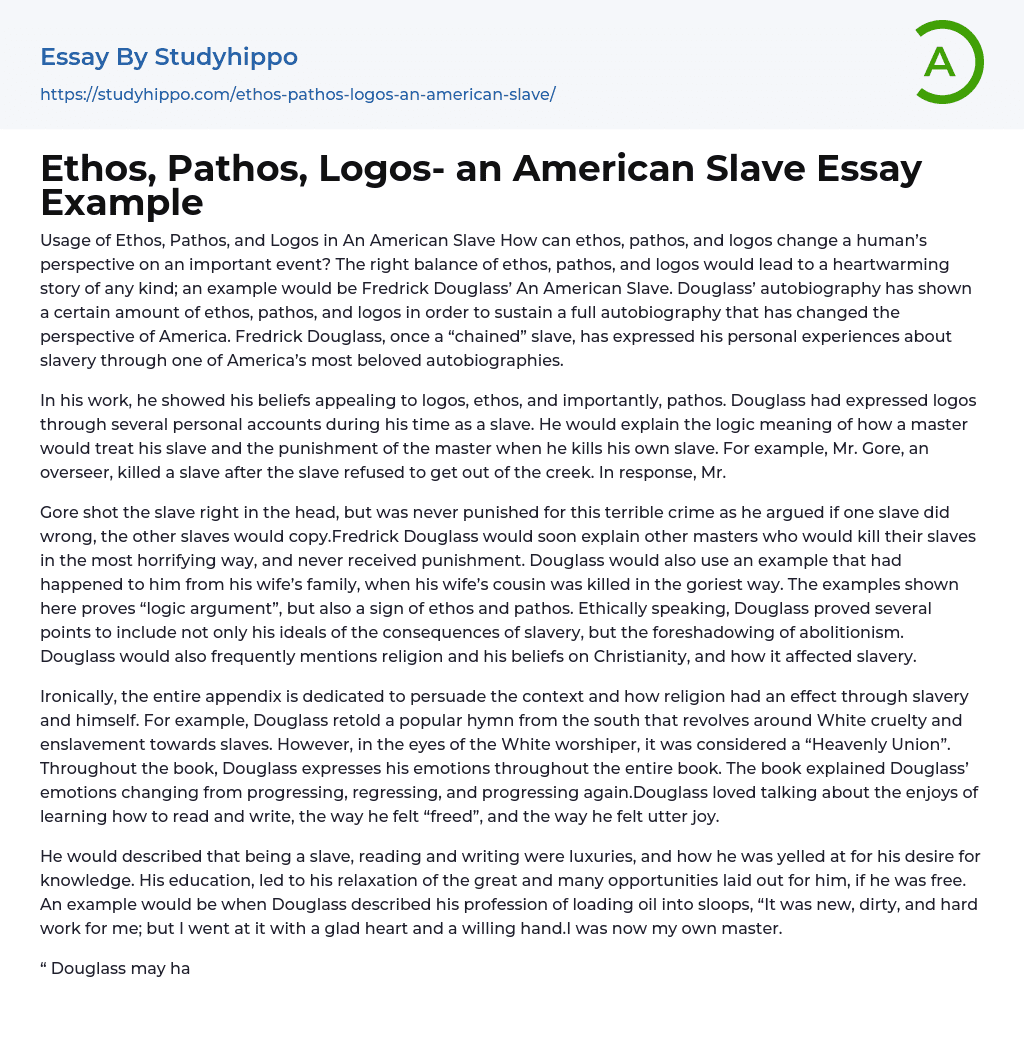Usage of Ethos, Pathos, and Logos in An American Slave How can ethos, pathos, and logos change a human’s perspective on an important event? The right balance of ethos, pathos, and logos would lead to a heartwarming story of any kind; an example would be Fredrick Douglass’ An American Slave. Douglass’ autobiography has shown a certain amount of ethos, pathos, and logos in order to sustain a full autobiography that has changed the perspective of America. Fredrick Douglass, once a “chained” slave, has expressed his personal experiences about slavery through one of America’s most beloved autobiographies.
In his work, he showed his beliefs appealing to logos, ethos, and importantly, pathos. Douglass had expressed logos through several personal accounts during his time as a slave. He would explain the logic meaning of
...how a master would treat his slave and the punishment of the master when he kills his own slave. For example, Mr. Gore, an overseer, killed a slave after the slave refused to get out of the creek. In response, Mr.
Gore shot the slave right in the head, but was never punished for this terrible crime as he argued if one slave did wrong, the other slaves would copy.Fredrick Douglass would soon explain other masters who would kill their slaves in the most horrifying way, and never received punishment. Douglass would also use an example that had happened to him from his wife’s family, when his wife’s cousin was killed in the goriest way. The examples shown here proves “logic argument”, but also a sign of ethos and pathos. Ethically speaking, Douglass proved several points to include not only his ideals of the consequences
of slavery, but the foreshadowing of abolitionism. Douglass would also frequently mentions religion and his beliefs on Christianity, and how it affected slavery.
Ironically, the entire appendix is dedicated to persuade the context and how religion had an effect through slavery and himself. For example, Douglass retold a popular hymn from the south that revolves around White cruelty and enslavement towards slaves. However, in the eyes of the White worshiper, it was considered a “Heavenly Union”. Throughout the book, Douglass expresses his emotions throughout the entire book. The book explained Douglass’ emotions changing from progressing, regressing, and progressing again.Douglass loved talking about the enjoys of learning how to read and write, the way he felt “freed”, and the way he felt utter joy.
He would described that being a slave, reading and writing were luxuries, and how he was yelled at for his desire for knowledge. His education, led to his relaxation of the great and many opportunities laid out for him, if he was free. An example would be when Douglass described his profession of loading oil into sloops, “It was new, dirty, and hard work for me; but I went at it with a glad heart and a willing hand.I was now my own master.
“ Douglass may have the right balance of the usage of ethos, pathos , and logos, but he used pathos more than the rest as he felt that his emotion was important. The over usage of pathos was probably one of the reasons why his narrative sold so well as people would want to understand the life of a slave. Importantly, Douglass wanted to educate the whole world of
abolitionism, and let his audience understand the life he went through.
- Slave Trade essays
- Abolitionism essays
- Adam Smith essays
- American History essays
- American Revolution essays
- Ancient Egypt essays
- Articles Of Confederation essays
- Atlantic Slave Trade essays
- Aztec essays
- Benjamin Franklin essays
- Civil Rights Act of 1964 essays
- Civil Rights Movement essays
- Civil war essays
- Cleopatra essays
- French And Indian War essays
- Gettysburg essays
- Great Depression essays
- Hurricane Katrina essays
- Industrial Revolution essays
- Jamestown essays
- Manifest Destiny essays
- Mccarthyism essays
- Patrick Henry essays
- Pearl Harbor essays
- Pocahontas essays
- Prohibition essays
- Pyramids essays
- Salem Witch Trials essays
- Slavery essays
- The New Deal essays
- Thirteen Colonies essays
- Westward Expansion essays
- Acceptance essays
- Age Of Enlightenment essays
- Child Observation essays
- Confucianism essays
- Conscience essays
- Critical Reflection essays
- Destiny essays
- Determinism essays
- Empiricism essays
- Environmentalism essays
- Epistemology essays
- Ethics essays
- Ethos essays
- Existence essays
- Existentialism essays
- Fate essays
- Free Will essays
- Functionalism essays




